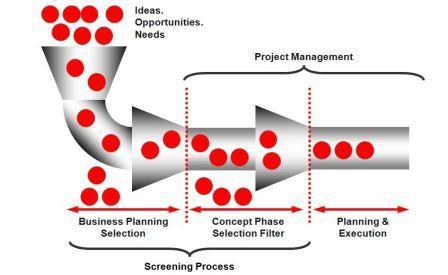
Sign #1: Project and resource managers often fight over resources.
Example: The head of the Finance department asked IT services to install a new accounts payables system. When approached by the project manager, requesting to assign two financial analysts to formulate the requirements of the system, the Director replies with unequivocal, "Are you nuts? There are too busy!"
Sign#2: Priorities of projects frequently change, with resources reassigned from one project to another.
Example: At the beginning of the year the CEO of your company announces that project A is the most important endeavor and will have the highest priority when it comes to resources - both financial and human. Sometime in March you suddenly discover the project manager of project A aimlessly wondering the hallways of your office. When you inquire about the status of her project, she lethargically replies, "Oh, the strategic priorities have shifted ... All resources have been reassigned to project B! And by the way, my deadline and scope remain unchanged."
Sign#3: Senior managers have authority to unilaterally approve and release projects.
Example: Your recent project got initiated simply because the CEO of your company walked into the conference room and uttered something to the effect of, "Wouldn't it be really cool if we could do this!" No feasibility study, no conversation with your technical or marketing experts. Nothing.
Sign#4: Projects are started as soon as approved by senior managers, irrespective of the resource availability.
Example: Project C has been approved by the executive committee and the project manager has been assigned to run the new initiative. Unfortunately, right at the Initiation stage, he hears the following from the PMO Manager, "I hope this project does not require too many resources. We simply don't have any ... People are too busy working on other tasks. Just be creative and deliver this!"
Sign#5: Projects are frequently late and/or over budget and/or do not deliver the full scope promised despite the fact that project managers are following all the best practices.
Example: The technical resources assigned to the projects are so overworked that they simply do not have enough time to dedicate to any specific task. This results in mistakes and quality shortcomings which leads to rework and missed deadlines.
Sign#6: Even if the strategic idea is implemented, the company sometimes does not achieve the expected improvement.
Example: Project D has been completed on-time and on-budget with full scope delivered. However one year later you look back and discover that the organization failed to realize any value from its implementation (e.g. the new CRM system is not being used by your sales team or the new marketing campaign failed to reach its ROI threshold).
Sign#7: There is no comprehensive document or portfolio that links all of the organization’s projects to the strategic plan.
Example: No one at the organization can answer a simple question: "Why are we doing this project?"
Sign#8: There is a significant turnover at the senior management level, right up through the president.
Example: The new CEO has been appointed several years ago. She started her tenure by promising to "take the company into the 21st century" by "being lean" and becoming "the market leader in innovation" ... Several years later she is dismissed, the new president comes in and delivers the same speech. The cycle repeats infinite number of times.
Sign#9: Strategic plan is presented as a list of initiatives. The cause-effect logic tying those initiatives to the goals of the organization is absent.
Example: The impact of any given project on the company strategy is not well understood. For instance, nobody bothers to ask: "If our company strategy is to aggressively go after Asian markets, why the heck are we opening a branch in Brussels?"
Sign#10: The list of initiatives is not prioritized. Therefore, it is assumed that all ideas should be implemented simultaneously
Example: The CEO states something to the effect of, "ALL of these projects are important and the Executive Board expects you to implement them concurrently. Needless to say they ALL have to be on-time and on-budget!"
About the Author
Jamal Moustafaev, MBA, PMP – president and founder of Thinktank Consulting is an internationally acclaimed expert and speaker in the areas of project/portfolio management, scope definition, process improvement and corporate training. Jamal Moustafaev has done work for private-sector companies and government organizations in Canada, US, Asia, Europe and Middle East. Read Jamal’s Blog @ www.thinktankconsulting.ca
- Please follow me on Twitter:
- Like our page on Facebook:
- Connect with me on LinkedIn:
- Subscribe to my RSS feed:
Jamal is an author of two very popular books: Delivering Exceptional Project Results: A Practical Guide to Project Selection, Scoping, Estimation and Management and Project Scope Management: A Practical Guide to Requirements for Engineering, Product, Construction, IT and Enterprise Projects.

